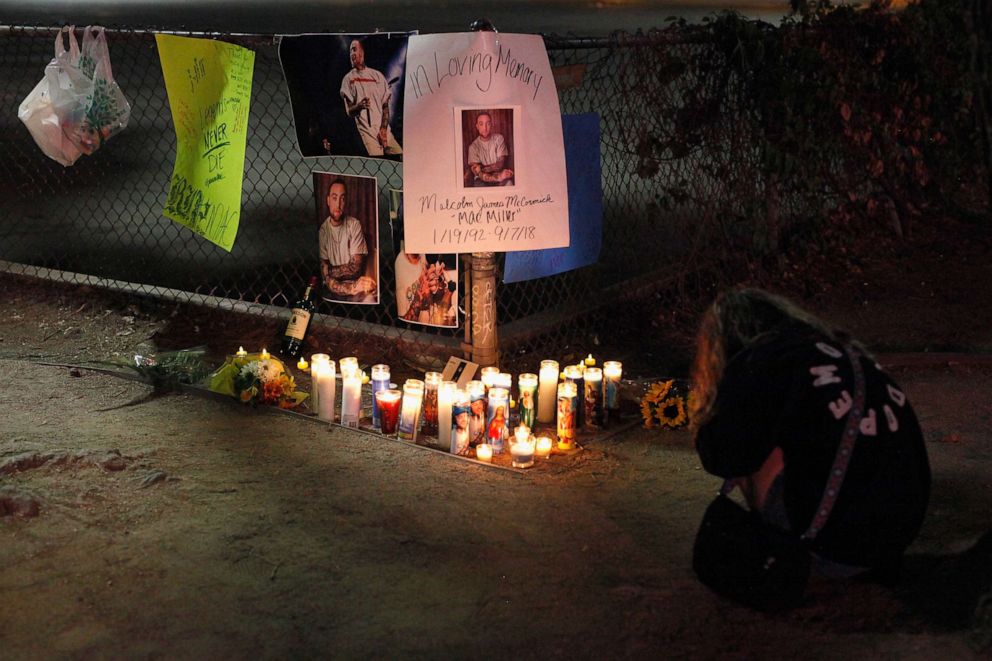'It’s an overdose crisis': Mac Miller's death investigation highlights a dangerous trend in the opioid epidemic
More than a year after his tragic overdose, Mac Miller’s lyrics serve as an eerie reminder of the cyclical nature of addiction and the all-consuming power of a disease that is plaguing America.
“You can love it, you can leave it/ They say you're nothing without it,” he raps on “What’s the Use?” from his Grammy-nominated album, “Swimming.” “Don't let them keep you down/ What if I don't need it?/There's somethin' about it that just freaks me out/ I just want another minute with it … Get a little sentimental when I'm off the juice.”
The late 26-year-old Pittsburgh rapper, whose given name is Malcolm James McCormick, was found unresponsive at his Los Angeles-area home on Sept. 7, 2018, and was declared dead soon after.
Miller had fentanyl, cocaine and ethanol in his system and died of mixed drug toxicity, according to the toxicology report.
Federal investigators announced charges earlier this month against three men in the overdose death of the hip-hop star, alleging they illegally distributed narcotics to the rapper, including counterfeit pharmaceutical pills containing fentanyl, which led to his death.

Cameron Pettit and Ryan Reavis pleaded not guilty in federal court in Los Angeles. Pettit's attorney, John Robertson, did not respond to ABC News’ request for comment, while Reavis' attorney, James Cooper, told ABC News that he has “no comment at this time.”
Meanwhile, Stephen Walter’s attorney, William Harris, confirmed to ABC that his client is scheduled to be arraigned on Oct. 31 and will also enter a not guilty plea.
“Counterfeit pharmaceutical pills are especially dangerous because users are unable to verify what they are ingesting,” William D. Bodner of the Drug Enforcement Administration’s Los Angeles field division and special agent in charge of the investigation said in a statement. “The tragic death of Mac Miller is a high-profile example of the tragedy that is occurring on the streets of America every day.”
Addiction crisis turns deadly amid 'war on drugs'
Historian David Herzberg, who studies the history of prescription drug abuse in America and drugs in popular culture, told ABC News that Miller’s overdose death is a stark reminder of how deadly the opioid epidemic has become.
“There’s a difference between an addiction crisis and an overdose crisis,” he said. “We started with an addiction crisis and now it’s an overdose crisis.”
The addiction epidemic in the U.S. began in the mid-1990s with the rise of big pharma and the launch of drugs like OxyContin in 1996, but by the late 2000s, it had transformed into an overdose epidemic, according to Herzberg.

More than half a million Americans died from drug overdoses from 2000 to 2015, and opioids – both prescription and illicit – have been the “main drivers of increases in drug overdose deaths over the past 15 years,” according to a 2017 report by the Drug Policy Alliance (DPA) — a non-profit organization dedicated to ending the “war on drugs.”
Lindsay LaSalle, the managing director of public health law and policy at the DPA, told ABC News that in the early 2000s, there was “an influx of opioid related prescriptions into various communities” that was “largely unregulated.”
To limit access, federal and state laws were passed to crack down on pill mills, doctor and pharmacy shopping, and prescription monitoring drug databases were implemented, making it more difficult for users to obtain these prescriptions.
These policies targeting consumers ended up cutting people off from their supply, LaSalle said, so in desperation, they turned to the street market, causing a boom in an industry where counterfeit or mixed drugs have become rampant.
“It became an overdose crisis for a preventable reason — It was a policy failure on our part,” Herzberg said. “The policy failure was that we accepted a ‘drug war’ story about what was going wrong, which was that evil drug abusers were exploiting the medical system,” he added. “That policy didn’t take into account the role of the pharmaceutical industry, instead and as a result, consumers were hurt.”
Fentanyl floods market amid illicit drug sale boom
According to the Drug Policy Alliance report, the most recent spike in overdose deaths is attributed to illicitly manufactured fentanyl — a synthetic opioid pain reliever that is often prescribed to treat severe pain, regularly in cases of advanced cancer and, according to the Centers for Disease Control, it is 50 to 100 times more potent than morphine.

LaSalle said that fentanyl became more popular over the past five years amid a boom in the street market. Unable to obtain prescription pills, many people turned to heroin in 2010 and when the market could not support the rising demand for the drug, suppliers turned to fentanyl, which is cheaper and faster to produce.
“In 2013 we started to see the first wave of an influx of fentanyl adulteration because it’s significantly cheaper to produce and it’s much more potent,” LaSalle said, adding that drug suppliers began cutting it into their supply — often in heroin — to meet demand and reduce costs.
In the statement announcing the charges in the Miller case, United States Attorney Nick Hanna pointed to the role of fentanyl in driving the overdose crisis.
“It has become increasingly common for us to see drug dealers peddling counterfeit pharmaceuticals made with fentanyl. As a consequence, fentanyl is now the No. 1 cause of overdose deaths in the United States," he said.
Amid this public health crisis, the music world also lost pop legend Prince, who died of an accidental fentanyl overdose on April 21, 2016.

And in 2017, 21-year-old rapper Lil Peep — a rising star known for blending hip-hop with emo sounds, who had been open about his struggles with addiction — shocked his young fans when he died of an accidental overdose of fentanyl and a generic brand of Xanax.
“People with addiction use a lot of drugs and they know how much they can use safely. When they die, unless they’re suicidal, it’s always because didn’t know what they were using,” Herzberg said.
According to a study in JAMA Network Open, published this year, the number of opioid-related deaths in the U.S. has more than quadrupled in the past 18 years.





